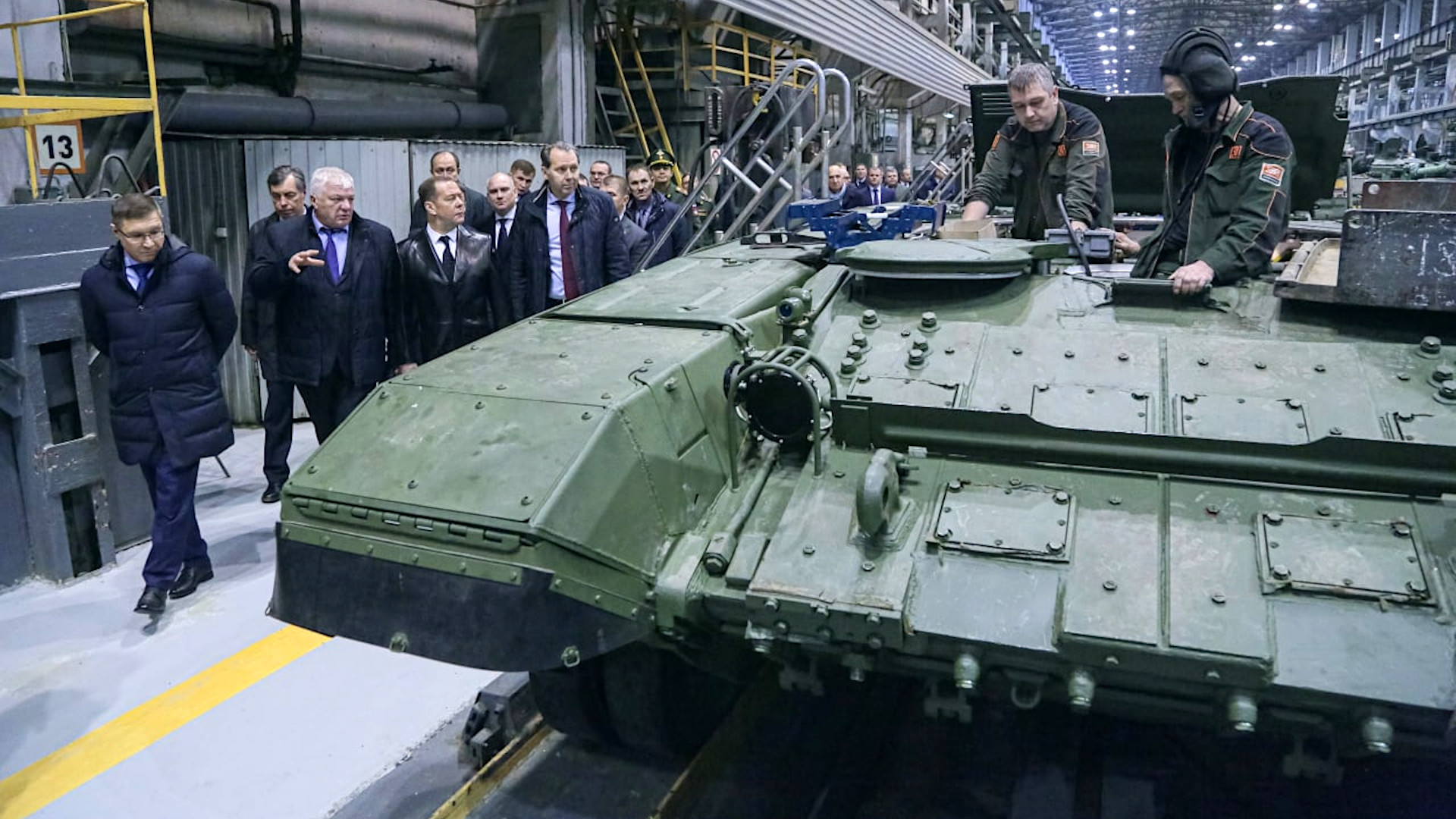Dmitry Medvedev, a former Russian President and ally of Vladimir Putin who is currently Deputy Chairman of the Security Council of Russia, has made implicit threats to bring officials from the country’s state-run defense industries up on criminal charges for failing to meet production goals.
Medvedev drew specific attention to the potential consequences of failing to meet contract requirements during a visit to the country’s main tank plant in Nizhny Tagil today. This comes amid reports that Russia has been digging deep into stocks of Cold War-era tanks that are virtually antiques to make up for the decaying readiness of high-tech armored vehicles and staggering losses in the fighting in Ukraine.
Medvedev described his visit to Nizhny Tagil – which he said came at the direction of Supreme Commander-in-Chief Putin – in a post on the Telegram social media network. This was accompanied by a short video showing T-72B3 and T-90M tanks are seen in various stages of production. The T-90M, examples of which have now been captured and destroyed by Ukrainian forces in the course of the conflict in that country, is the most advanced tank currently in active Russian service.
“The production of weapons and special equipment of all types is increasing manyfold: from tanks and guns to high-precision missiles and drones,” Medvedev wrote in his post on Telegram, but did not provide more specific details. “Brace yourself!”
Perhaps more tellingly, Medvedev – who toured the factory floor in a black leather trench coat that drew comparisons to Stalinist and fascist aesthetics – made clear what could happen to defense enterprises that perform poorly.
“The goal has been set for a scrupulous execution of the government’s defense contracts in all of its key parameters, [and] prevention of disruptions in the supply of equipment,” he wrote on Telegram. “Attention has been drawn to the fact that all contractors could be held to account, including on criminal charges… Supervision over the execution will continue.”
Since Russia launched its all-out invasion of Ukraine in February, crippling western sanctions have increasingly prompted questions about the country’s ability to produce weapons, ammunition, and other military equipment, especially more advanced systems. Various higher-end Russian weapon systems, including tanks like variants of the T-90, rely heavily on western electronics and electronic subcomponents.
The Kremlin’s decision to acquire Iranian drones and potential plans to buy short-range ballistic missiles from that country, as well as reported possible purchases of North Korean artillery shells, have only added evidence that Russia’s domestic defense industrial base is facing serious issues. There were media reports in March that Russian state-run conglomerate Uralvagonzavod had ordered a pause in the production of tanks at Nizhny Tagil due to a lack of necessary parts. Though they did not confirm them, U.S. officials highlighted those reports at the time as an example of export controls having their intended effect.
On top of that, building or otherwise finding replacement tanks has already clearly been a particular issue for Russia. Independent open-source intelligence group Oryx has visually cataloged more than 1,400 lost Russian tanks, a total that includes abandoned and captured examples, as well as damaged and destroyed ones, since its war on Ukraine began. The true scale of Russian tank and other armored vehicle losses is likely much greater.
Though Russia has thousands of tanks in deep storage on paper, it is understood that a significant number of these, if not most of them, are essentially unserviceable. Reports earlier this month that the Russian military may be looking at refurbishing around 800 thoroughly obsolete Cold War-era T-62Ms, and potentially modernizing them, at least to some degree, over the next three years provided fresh evidence that the pool of readily available tanks in storage is already dwindling.

Though the conflict in Ukraine has renewed debates about whether tanks and other heavy armored vehicles are increasingly obsolete, in general, on modern battlefields, both sides have and continue to use them actively in the fighting. Ukrainian officials have continued to press their international partners in recent months to transfer more modern tanks to help keep offensives in the southern and eastern ends of the country moving forward.
It’s not clear if Medvedev’s implicit threats will, or even can, have any effect on the tank situation or other aspects of the country’s defense industrial supply chain woes. President Putin’s declaration of a partial mobilization in September has, at least so far, primarily manifested itself in a controversial and often chaotic draft, rather than a broader shift of the country’s economy and industrial bases to a wartime footing.
One might wonder if there is now a possibility we could see Russia importing tanks, or kits produce tanks, from countries like Iran or North Korea.
All told, it remains to be seen what exactly Russia will be ‘bracing’ itself for following the Deputy Chairman of Russia’s Security Council’s tour of Nizhny Tagil.
Contact the author: joe@thedrive.com

